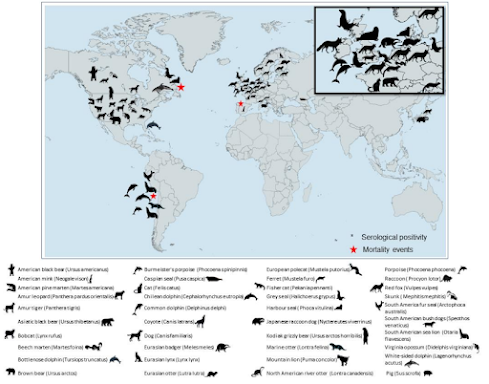#17,664
A little over a year ago we followed reports of unusual mortality events in New England (see Maine: Seal Deaths Linked To Avian H5N1) and Canada (see Quebec: Seal Deaths Linked To Avian H5N1) involving hundreds of marine mammals killed by the recently arrived HPAI H5 virus.
Since then, we've seen much larger (> 20,000 animal) die-offs of seals, sea lions, dolphins, and other animals from HPAI H5 up and down the South American Coast (see Chile: SERNAPESCA Reports > 3500 Marine Animal Deaths In July), as well as scattered reports in Europe and Russia.
We've known for decades that marine mammals are susceptible to influenza A viruses (see here, here, and here), but HPAI H5 has become unusually widespread - and has proven particularly deadly - in these sea creatures over the past year.
Up until now, HPAI has not been confirmed in marine mammals from the west coast of the United States, but yesterday we got confirmation of 3 infected seals recovered from Puget Sound in August.
Highly Pathogenic Avian Influenza Found in Seals on Marrowstone Island in Puget Sound
September 08, 2023
Test results confirm H5N1; officials urge beachgoers to avoid contact with wildlife.
The U.S. Department of Agriculture’s National Veterinary Services Laboratories has confirmed that three adult harbor seals in Puget Sound have tested positive for the Highly Pathogenic Avian Influenza H5N1 strain. The seals stranded on Marrowstone Island on August 18 and 25. This confirms initial testing by the Washington Animal Disease Diagnostic Laboratory, which indicated the presence of H5N1 in these seals. No seal pups have tested positive.
This marks the first incidence of HPAI in marine mammals on the West Coast. This discovery follows an ongoing HPAI outbreak affecting seabirds on Rat Island and Marrowstone Island since mid-summer. The outbreak resulted in the death of approximately 1,700 birds. The Islands are next to each other in the northern portion of Puget Sound, Washington. Fort Flagler State Park is on the northern tip of Marrowstone Island.
Avoid Contact with Wildlife
People and their pets should avoid all contact with sick or dead wildlife. HPAI is a “zoonotic disease” that has the potential to spread between animals and people (and their pets). Although the risk of infection to the general public remains low, beachgoers should not touch live or dead seals or allow pets to approach seals. They should maintain a safe distance of 100 yards.
The emergence of avian influenza in harbor seals and gray seals in Maine last year caused a spike in deaths over a short time period. That led NOAA Fisheries to declare an unusual mortality event to investigate the incident.
Avian Influenza and Seals
Puget Sound harbor seal populations number in the many thousands and are considered healthy. The disease is not expected to affect the species at a population level.
“The discovery of HPAI H5N1 in seals brings to light the potential for cross-species transmission and highlights the complexity of managing infectious diseases in wildlife populations,” says Kristin Wilkinson, NOAA Fisheries’ Regional Stranding and Entanglement Coordinator. “As the investigation continues, the collaboration among agencies remains essential to understanding and addressing this situation.”
Seals have been diagnosed with influenza before. In the late 1970s, the virus was detected in harbor seals in the Northeast United States, and again in the early 1980s. In the early 1990s, several seals died of pneumonia in Cape Cod, Massachusetts. Outside of the United States, the disease has been found in dead seals in Canada, Russia, the United Kingdom and several countries in South America.
Report Sick Animals
If you encounter sick, injured, or dead seals, call the West Coast Region Stranding Hotline: (866) 767-6114. Do not attempt to move sick wild animals as this can spread the disease. The Washington Department of Fish and Wildlife asks members of the public to report sick or dead wild birds using this online form.
As resources are available, biologists may respond to collect data and samples from carcasses. Stranding network personnel are taking precautions and wearing personal protective equipment when collecting samples from dead or live animals to ensure the safety of staff and other species.
NOAA Fisheries, in collaboration with marine mammal stranding network partners and governmental agencies, continues to investigate the incidents, and monitor the progress of the virus. The investigation provides an opportunity to learn more about the potential spillover of influenza viruses from avian species to marine mammals and the implications for the broader ecosystem.
Although H5N1 has been around (and a pandemic concern) for more than 2 decades, it has only been over the past couple of years that we've seen it spill over so aggressively into so many mammalian species (see ECDC/EFSA Chart below).While we could get lucky, and there may be some (as yet, unidentified) species barrier that prevents HPAI H5 from ever becoming a human pandemic (see Are Influenza Pandemic Viruses Members Of An Exclusive Club?), scientists and researchers around the world are increasingly concerned.
Last July, in WHO Statement: Ongoing Avian Influenza Outbreaks in Animals Pose Risk to Humans, the heads of WHO, FAO, and WOAH issued a statement on the changing risks from avian flu, and stressed the need for international cooperation in preventing what could become the next global health crisis.

